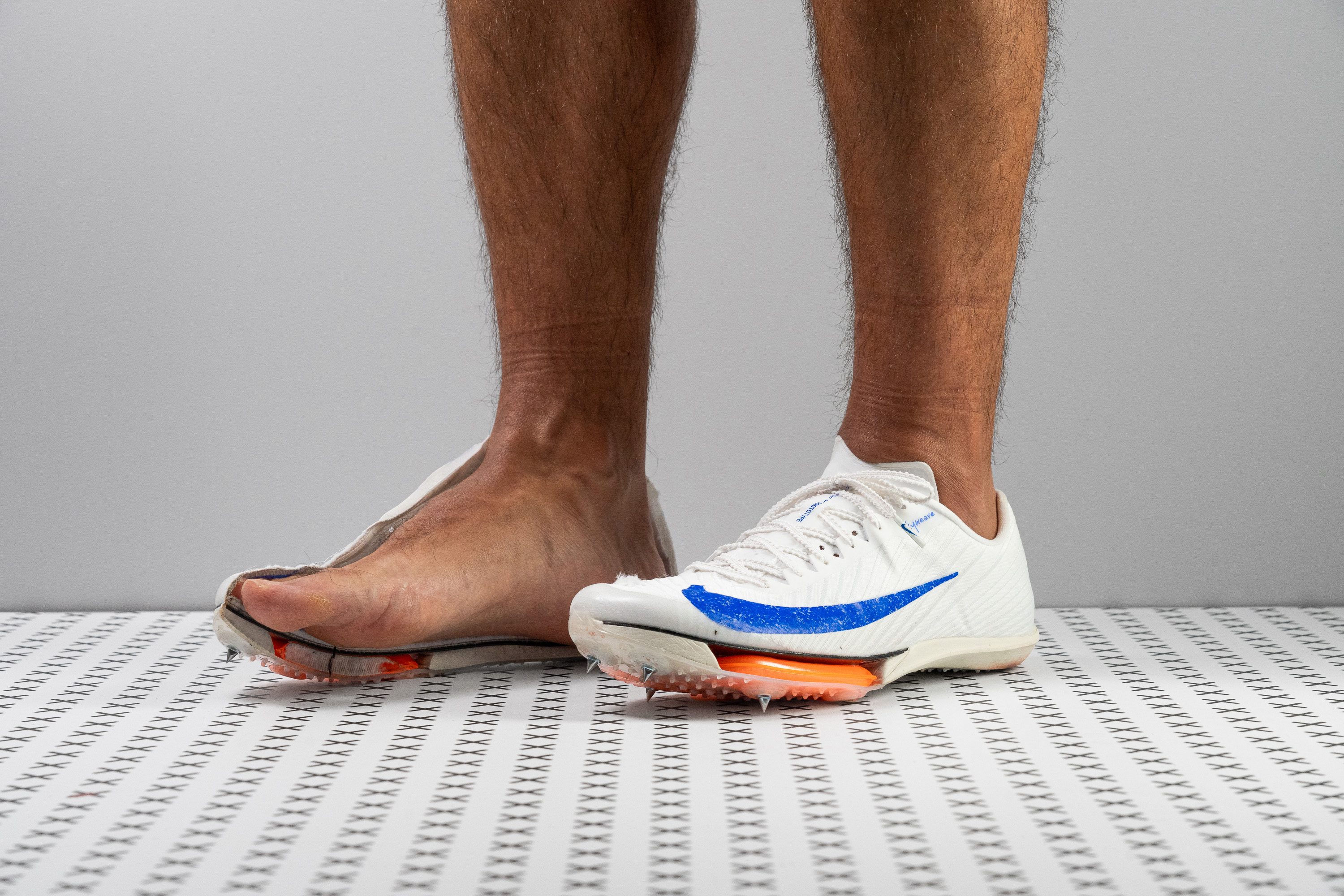Nuestra conclusión
Pros
- Pisada explosiva
- Ahora son más estables en el talón
- Diseño mejorado del mediopié
- Dos unidades Air Zoom
- Materiales de primera calidad
- Destacan en todo lo que esté por debajo de 800 m
- También se pueden usar para las vallas
- Placa de carbono rígida
Contras
- Siguen sin ser duraderas
- Más pesadas que la versión anterior
- Caras
Veredicto de los usuarios
- Top 29% entre Zapatillas de atletismo con clavos de velocidad
- Top 8% más vendidas zapatillas de atletismo
Comparativa
Las zapatillas de clavos más parecidas
+ + Añadir unas zapatillas | |||||
|---|---|---|---|---|---|
| Puntuación global | 94 Notables | 90 Notables | 90 Notables | 93 Notables | |
| Precio | 220 € | 250 € | 175 € | 200 € | |
| Peso laboratorio | 6.4 oz / 181g | 6 oz / 169g | 5.5 oz / 156g | 6.5 oz / 183g | |
| Transpirabilidad | Media | Media | Alta | Alta | |
| Uso | Sprints | VallasSprints | VallasSprints | VallasSprints | |
| Clavos extraíbles | ✓ | ✓ | ✓ | ✓ | |
| Anchura / ajuste | Media | Estrecha | Media | Media | |
| Anchura de la parte delantera | Media | Media | Media | Estrecha | |
| Drop laboratorio | -2.0 mm | -0.9 mm | 0.0 mm | -5.8 mm | |
| Talla | Tallan bien | Tallan un poquito pequeño | Tallan un poquito pequeño | Tallan bien | |
| Rigidez de la mediasuela | Equilibrada | Equilibrada | - | Equilibrada | |
| Acolchado de la lengüeta | Gruesa | Gruesa | Estándar | Gruesa | |
| Flexibilidad | Rígida | Rígida | Moderada | Rígida | |
| Rigidez torsional | Firmes | Firmes | Moderadas | Firmes | |
| Rigidez del contrafuerte del talón | Moderadas | Moderadas | Flexibles | Flexibles | |
| Grosor de la suela | Fina | Fina | Muy gruesa | Fina | |
| Tirador del talón | Ninguno | Ninguno | Tirador circular | Ninguno | |
| Altura de la suela en la zona del talón laboratorio | 15.7 mm | 15.9 mm | 12.3 mm | 11.0 mm | |
| Antepié | 17.7 mm | 16.8 mm | 12.3 mm | 16.8 mm | |
| Grosor de la plantilla | Gruesa | Estándar | Estándar | Estándar | |
| Anchura de la mediasuela - antepié | Estándar | Estándar | Muy estrecha | Ancha | |
| Anchura de la mediasuela - talón | Ancha | Estándar | Muy estrecha | Estándar | |
| Clasificación | #4 Top 31% | #9 30% inferior | #7 46% inferior | #5 Top 39% | |
| Popularidad | #1 Top 8% | #6 Top 47% | #4 Top 31% | #11 15% inferior |
Quién debería comprárselas
Creemos que las Maxfly 2 son ideales para:
- Los velocistas de élite que buscan batir sus marcas personales.
- Los amantes del atletismo que quieren unas zapatillas potentes y llenas de impulso sin preocuparse por su precio.
- Los fans de las Maxfly originales a los que les encantaron sus explosivas unidades Air Zoom y necesitan un nuevo par. ¡Es hora de actualizarse!
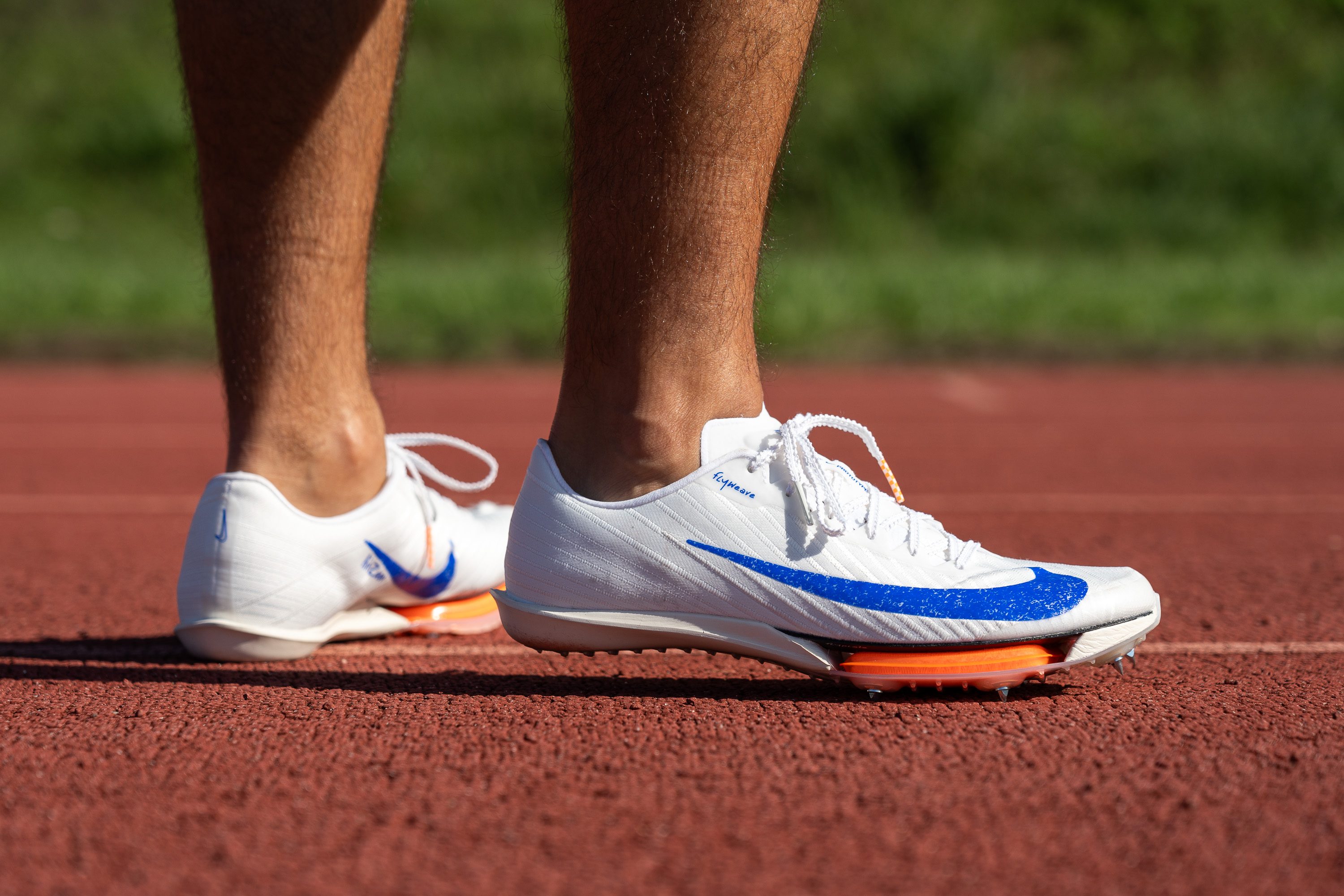
Quién NO debería comprárselas
Estamos bastante seguros de que las Maxfly 2 no son la mejor opción para los principiantes, ya que exigen una técnica excepcional y una potencia considerable para poder aprovechar su rendimiento al máximo. Según nuestra experiencia, que sean tan caras también las hace menos atractivas para los principiantes. Aquí, en nuestro laboratorio, hemos demostrado que las Nike Zoom Superfly Elite 2 son una opción más asequible y apta para principiantes.
También descubrimos que la durabilidad de las Maxfly 2 sigue siendo su punto débil, al igual que la primera versión, sobre todo si tenemos en cuenta su precio. Si estás buscando un par que dure, te recomendamos las Adidas Prime SP2, que destacan en este aspecto.
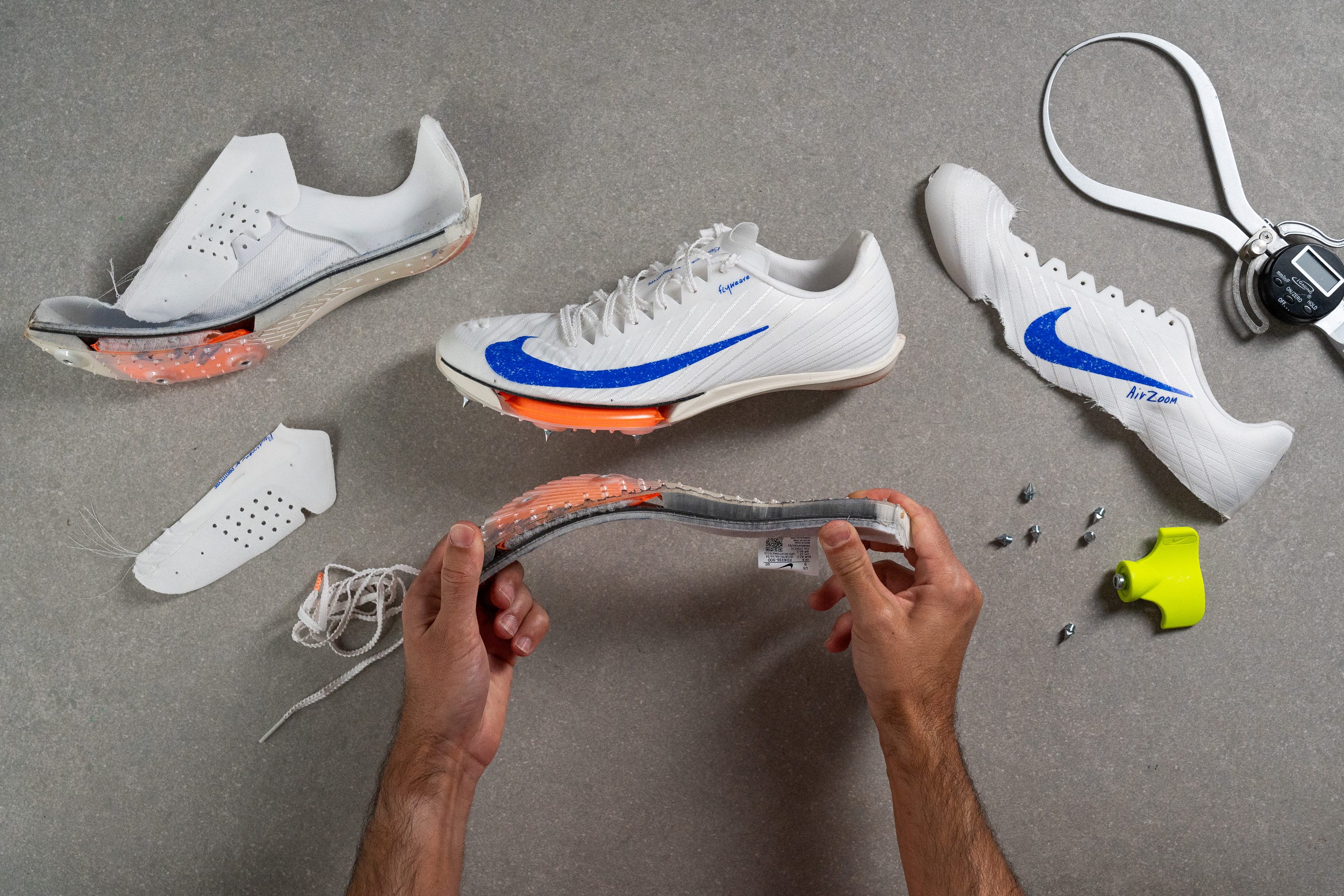
Amortiguación
Altura de la suela en la zona del talón
La altura de la suela en el talón es de 15,7 mm, que es más que lo que miden la mayoría de las zapatillas de clavos para sprints, ya que suelen estar más cerca del suelo.
Esta altura extra nos parece muy útil para los atletas que a veces pierden la forma al correr y terminan impactando un poco más atrás, sobre todo en esas carreras de 400 m u 800 m llenas de ácido láctico.
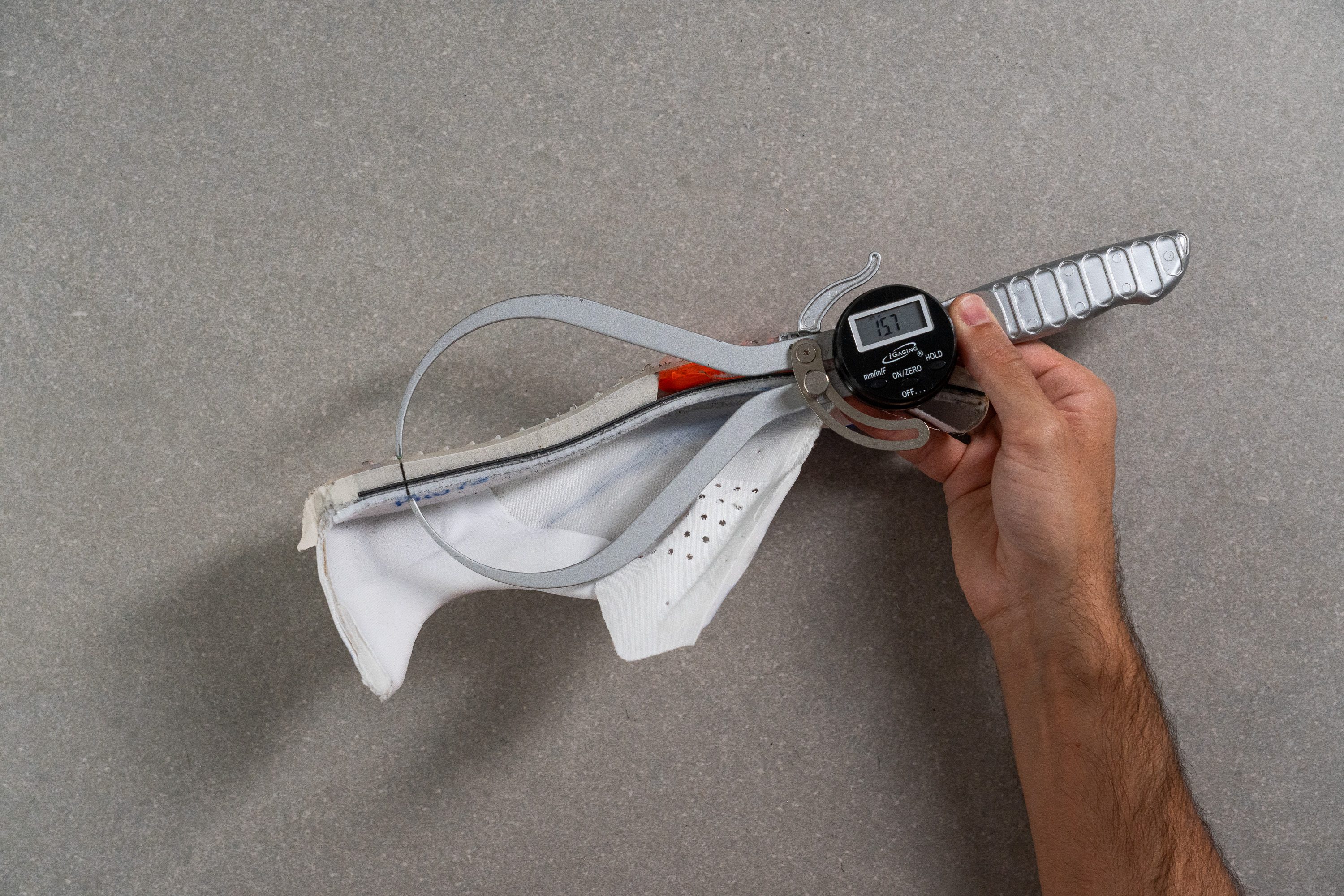
| Maxfly 2 | 15.7 mm |
| Media | 16.0 mm |
Altura de la suela en el antepié
El antepié tiene una altura de 17,7 mm, solo 2,3 mm por debajo del límite de los 20 mm impuesto por la World Athletic tras los Juegos Olímpicos de París de 2024. Por cierto, no tienen casi espuma en esta zona, la altura la llenan toda la plantilla, la placa y las unidades Air Zoom.
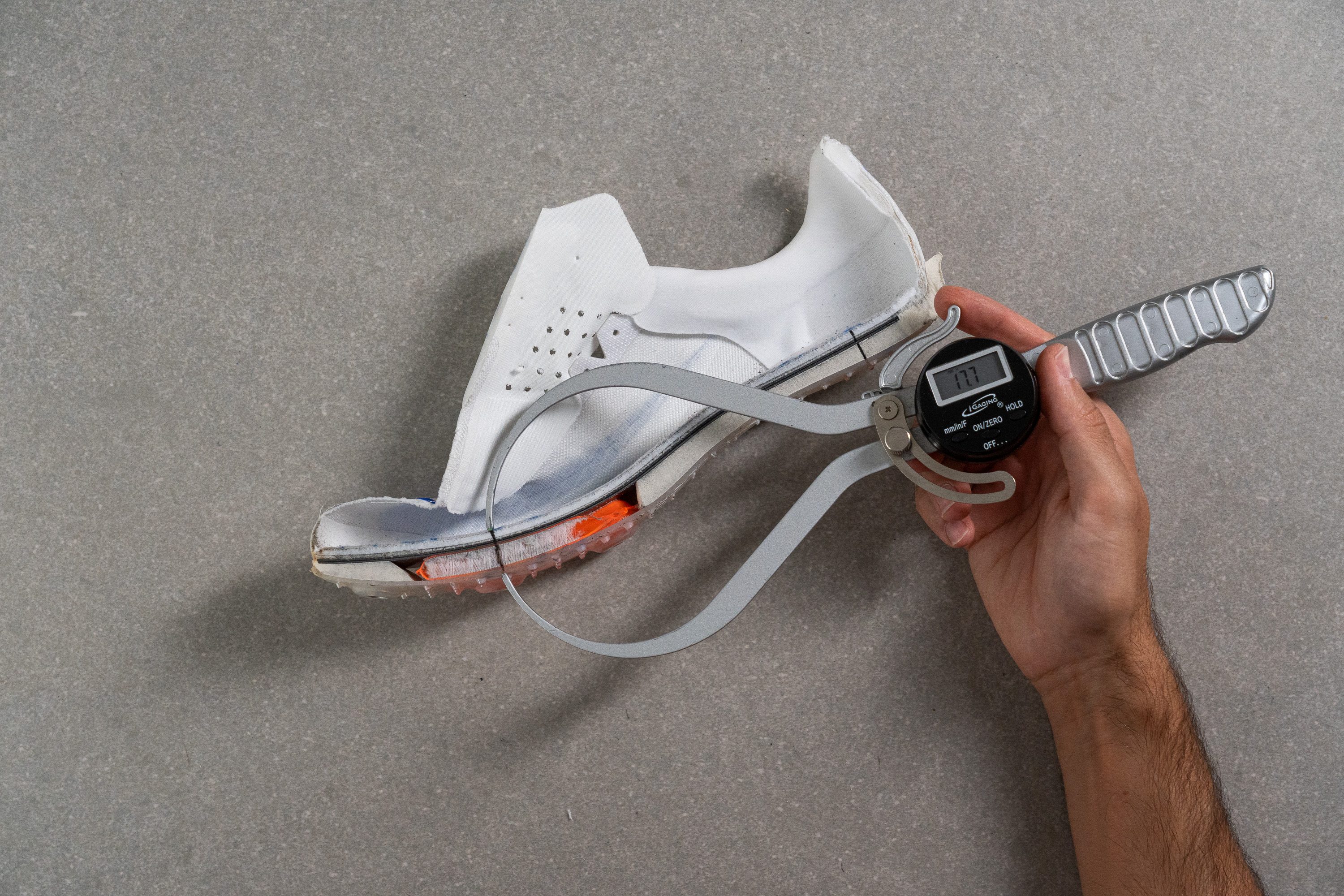
| Maxfly 2 | 17.7 mm |
| Media | 15.3 mm |
Drop
Después de hacer ambas medidas, nos encontramos con el mítico drop negativo de las zapatillas de clavos de velocidad de élite, con una diferencia de -2,0 mm.
Este diseño tan agresivo fomenta un golpeo potente con el antepié. Lo hemos probado y podemos confirmarte que, efectivamente, así es.
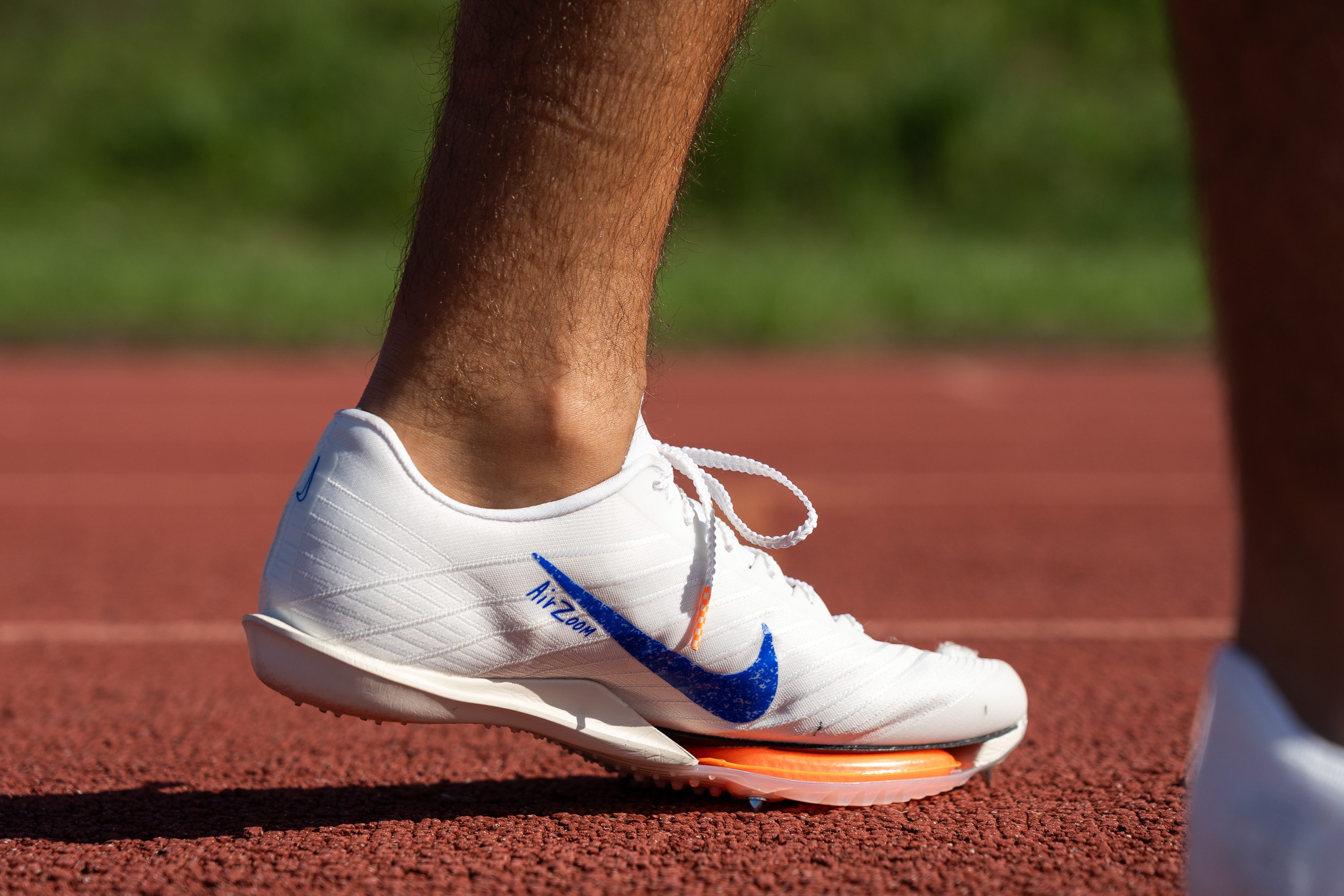
| Maxfly 2 | -2.0 mm |
| Media | 0.7 mm |
Suavidad de la mediasuela
Como hemos mencionado antes, no hay espuma en el antepié, pero Nike ha incluido su espuma ZoomX de primera calidad en el talón, el mismo material que se encuentra en modelos como las Vaporfly 3.

Analizamos esta espuma en nuestro laboratorio, y resulta que es más firme que otras versiones de la ZoomX, con una puntuación de 23,3 HA en nuestro durómetro. La verdad es que tiene todo el sentido del mundo si tenemos en cuenta la fina capa de las Maxfly, que está diseñada para que las zapatillas se mantengan ligeras y cerca del suelo.
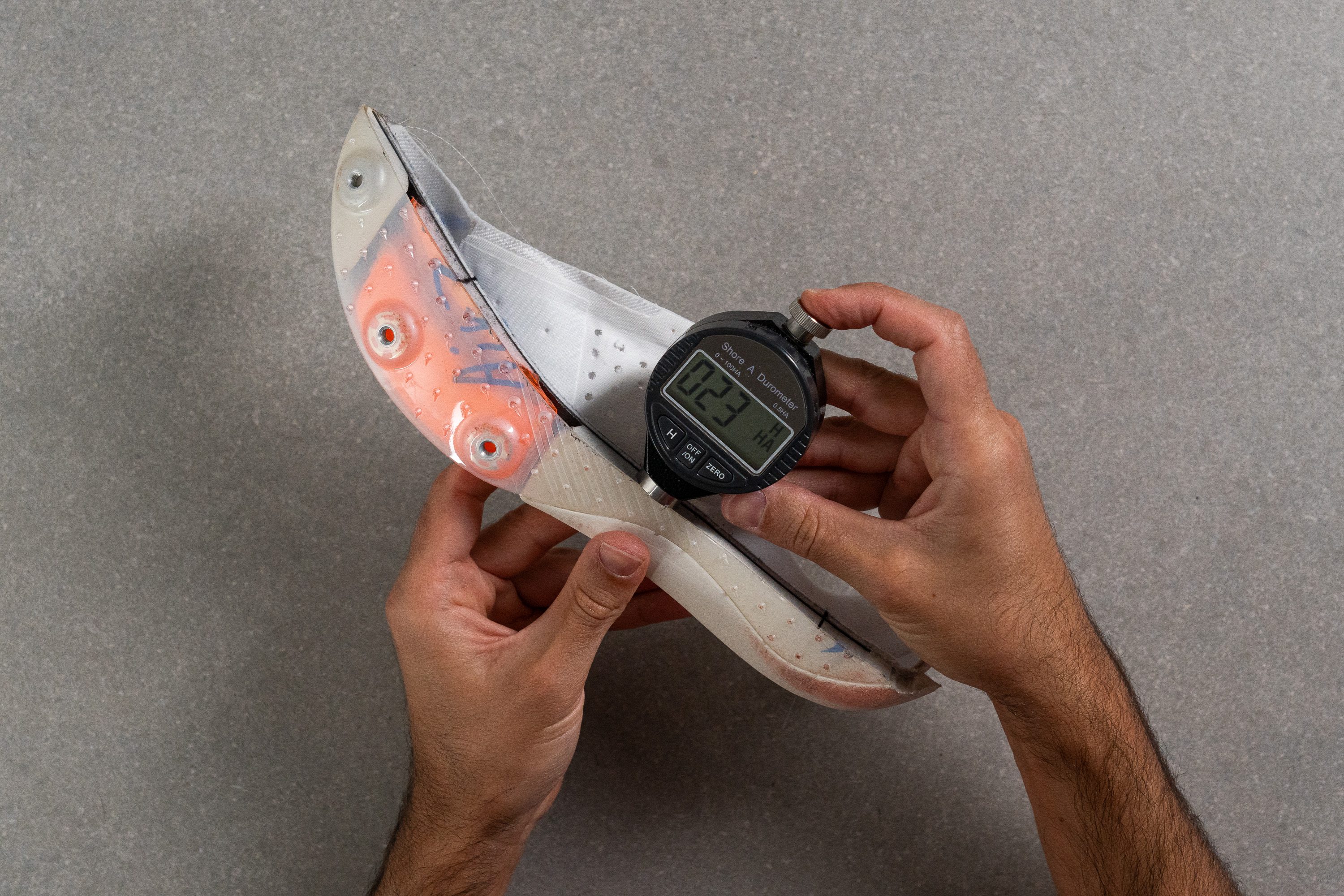
| Maxfly 2 | 23.3 HA |
| Media | 23.8 HA |
Air Zoom
Nike le ha dado mucho uso a su tecnología Air Zoom en la serie Maxfly, presentando de nuevo un diseño doble en el antepié que proporciona un rebote explosivo y un increíble retorno de energía. De hecho, creemos que ninguna espuma del mercado puede igualar el rebote de este par de unidades Air Zoom.
Placa
Al igual que en las Nike Alphafly 3, las unidades Air Zoom no pueden maximizar su pontencial ellas solas. Para aprovechar al máximo su energía explosiva, es esencial contar con una placa de fibra de carbono. Nike ha integrado la tecnología Flyplate de sus zapatillas de competición para correr por asfalto, asegurándose de que ambas unidades Air Zoom estén totalmente comprimidas para devolver tanta energía como sea posible.
Y como hemos comentado en nuestra guía sobre espumas, la espuma por sí sola no llega, ¡se necesita un agente endurecedor para conseguir el mejor retorno de energía posible!

Tallaje y ajuste
Talla
Las Nike Maxfly 2 tallan bien (89 votos).
Anchura / Ajuste
Después de echar nuestro gel mágico dentro de las zapatillas, comprobamos que Nike casi no había cambiado el ajuste de las Maxfly anteriores. Vamos, que sigue siendo un ajuste seguro, que ofrece sujeción y que es ideal para carreras de corta distancia.
Nuestro calibrador marcó 86,4 mm cuando medimos la parte más ancha del molde (entre el meñique y el dedo gordo), que es un resultado estándar.

| Maxfly 2 | 86.4 mm |
| Media | 88.4 mm |
Anchura de la parte delantera
Cuando medimos la anchura en la zona del dedo gordo, nuestro calibre marcó 70,7 mm, que es muy ancho para ser unas zapatillas de clavos de velocidad. Esto hace que sean una opción ideal para los atletas con pies cuadrados que suelen pasarlo mal con los modelos estrechos.
Curiosamente, el diseño de las zapatillas de clavos de Nike es casi parecido al de las zapatillas de running de Altra, que son anchas y tienen una parte delantera en forma de pie. Pero si hablamos de los modelos para correr por asfalto, entonces sí que recurren a un diseño más clásico y estrecho de su parte delantera. La verdad es que es un contraste muy curioso.
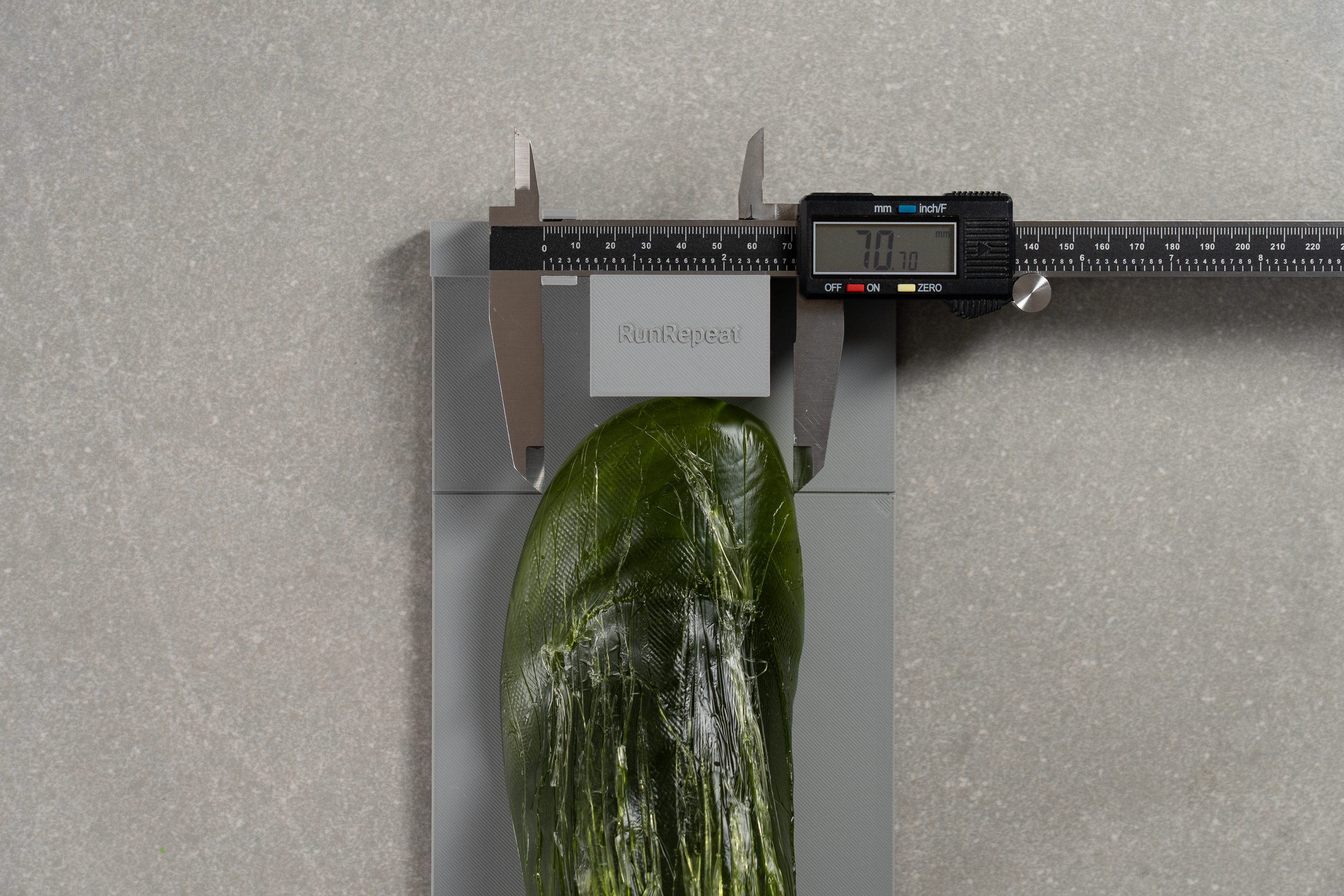
| Maxfly 2 | 70.7 mm |
| Media | 69.0 mm |
Altura de la parte delantera
La altura de la parte delantera y del mediopié sí que nos han parecido cómodas.
Si estás dentro del grupo de las personas que sintieron molestias con la versión original, creemos que solo con este detalle ya se puede justificar el ligero aumento de peso de este par. Cuando medimos la altura de su parte delantera, nuestro calibre marcó unos decentes 23,9 mm.
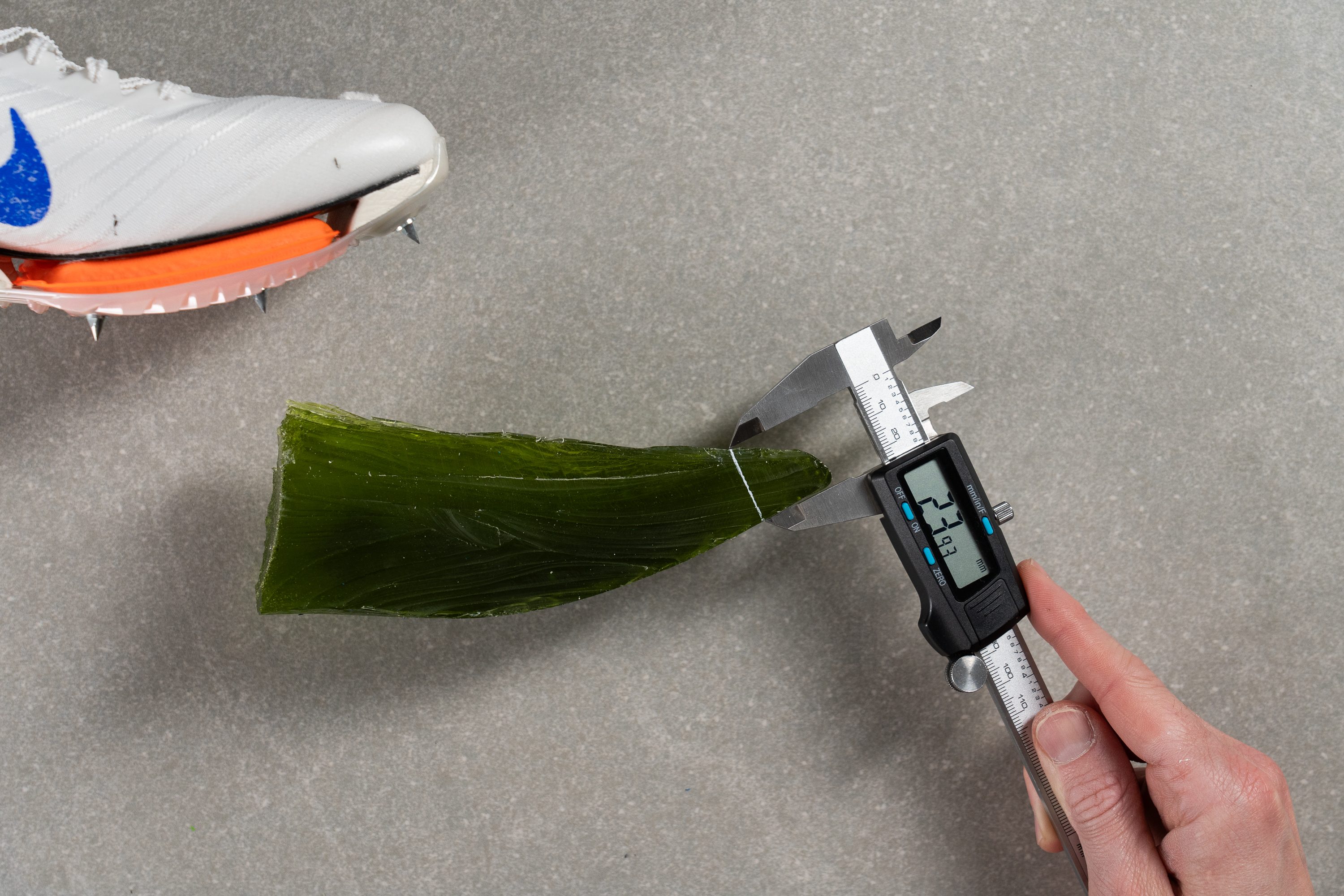
| Maxfly 2 | 23.9 mm |
| Media | 25.8 mm |
Flexibilidad / Rigidez
Que sí, que sí, que lo de que son rígidas lo decimos en serio.
Con un resultado de 22,5 N en nuestra prueba de flexión de 30 grados, ya te puedes ir preparando para que tus gemelos y tendones se pongan serios, porque las Maxfly 2 son difíciles de doblar. ¡Pero es que eso es justo lo que necesitas en las zapatillas de clavos de velocidad con placa y de alto rendimiento!

| Maxfly 2 | 22.5N |
| Media | 13.2N |
Peso
Algo que nos ha decepcionado de esta actualización es que pesa más. Las Maxfly 2 ahora pesan 181 g, superando a los 169 g de sus predecesoras.
¿Que si es un factor decisivo? Pues nosotros creemos que no. En nuestra opinión, las diferencias de 5-10 g entre pares son habituales por las variaciones de fabricación. Además, un aumento tan pequeño casi no se nota en términos de rendimiento. Pero sí, sigue sin ser lo mejor.
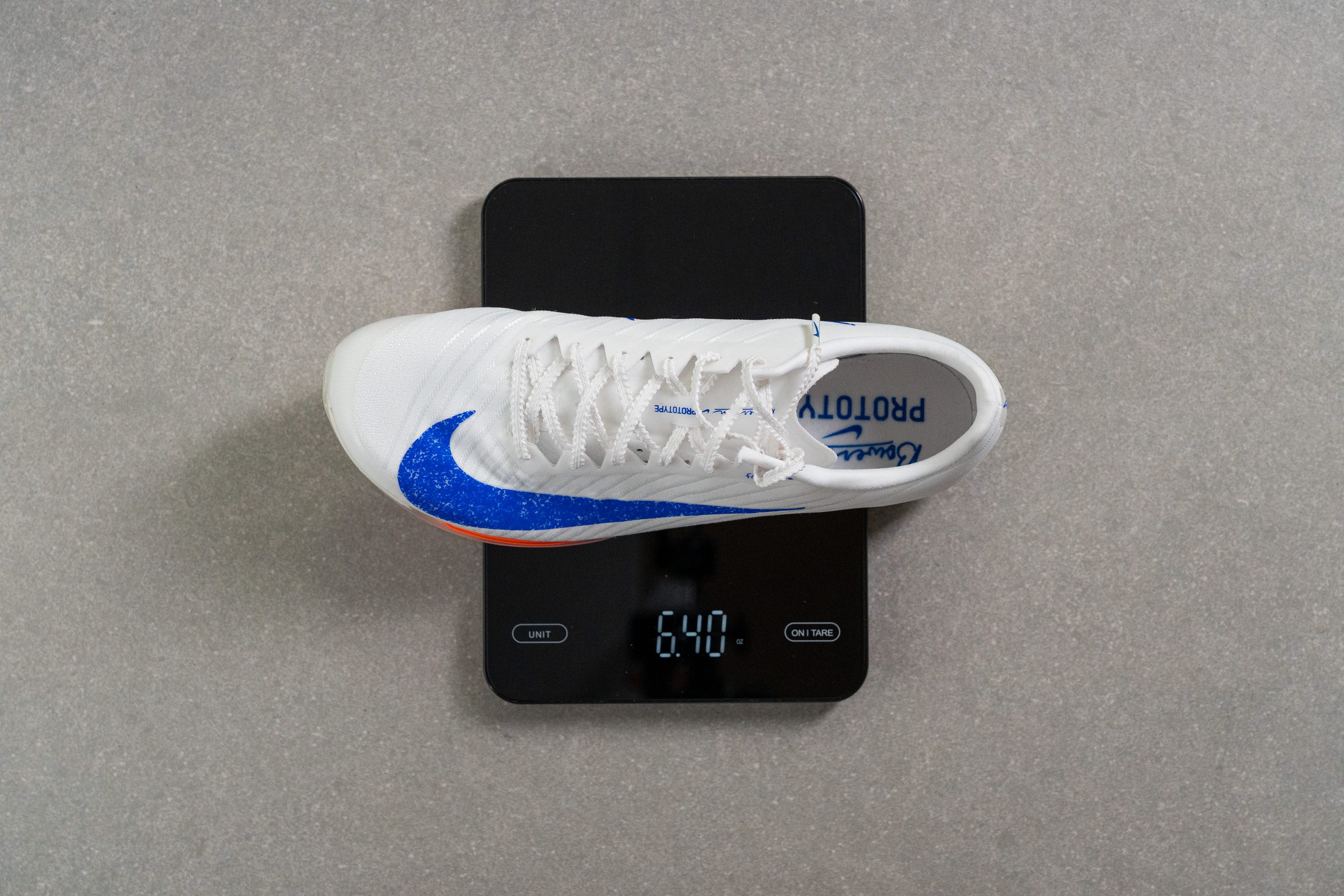
| Maxfly 2 | 6.4 oz (181g) |
| Media | 5.6 oz (158g) |
Transpirabilidad
Si te esperabas mejoras en cuanto a la transpirabilidad de las Maxfly 2, es normal que te sientas un poco decepcionado. En nuestra prueba de humo, su rendimiento fue menor del que esperábamos, llevándose solo un 3/5, igual que sus predecesoras. La diferencia en el flujo de aire nos queda clara en el siguiente vídeo al compararlas con las Nike Victory 2, unas zapatillas de clavos para media distancia.
Gracias a nuestra luz, comprendimos rápidamente por qué se quedan cortas en cuanto a ventilación. Nike optó por una parte superior más estructurada y gruesa para garantizar un ajuste ceñido y listo para competir, y la verdad es que lo entendemos. Al final, cuando el sprint dura 100 o 200 m, la transpirabilidad pasa a un segundo plano.
Pero hasta que no le echamos un ojo con nuestro microscopio no pudimos conocer bien del todo estos materiales.
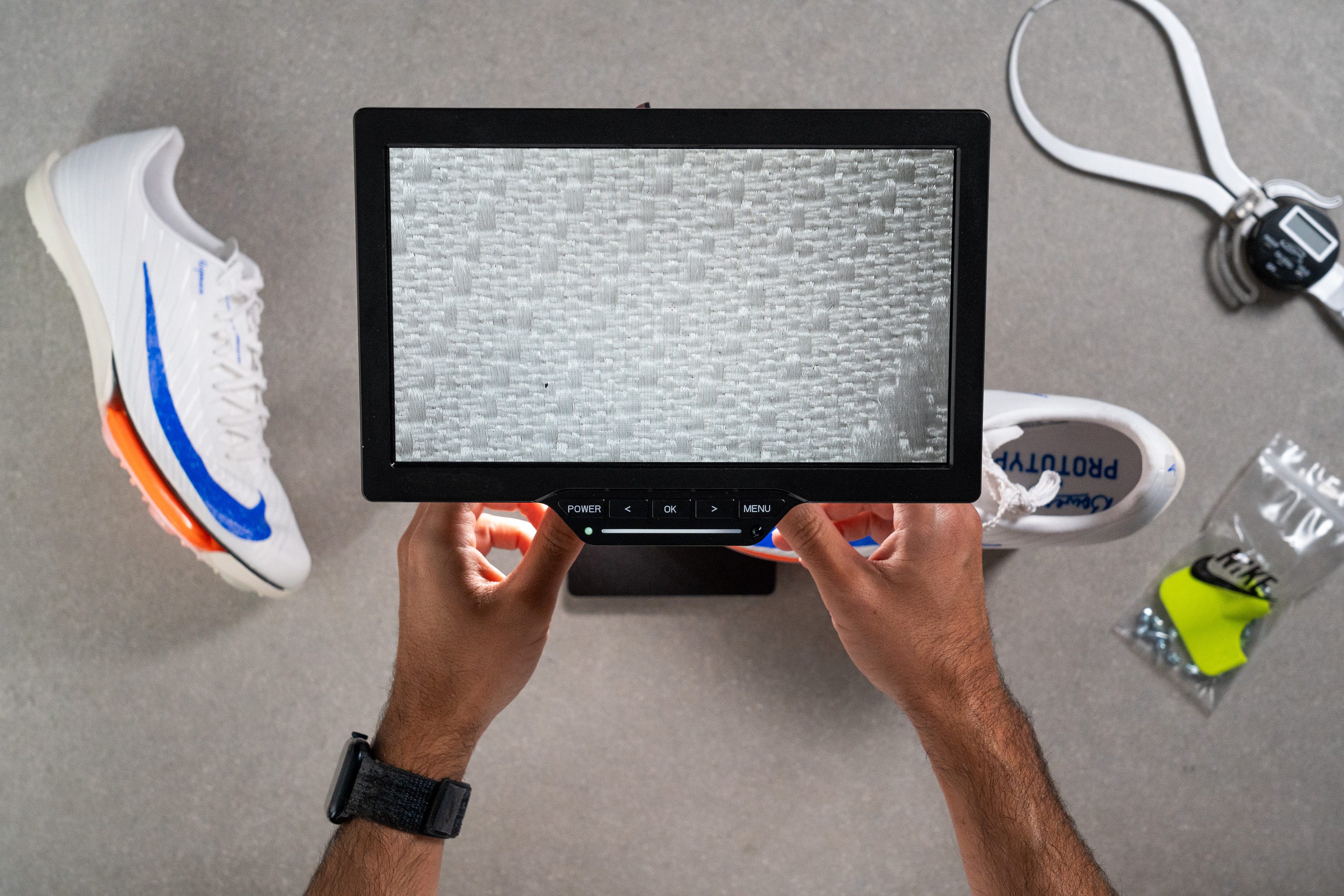
La parte superior Flyweave tiene es preciosa así de color blanco (en el modelo Bowerman Prototype), pero no deja que el aire salga prácticamente nada. ¡Así de fácil!
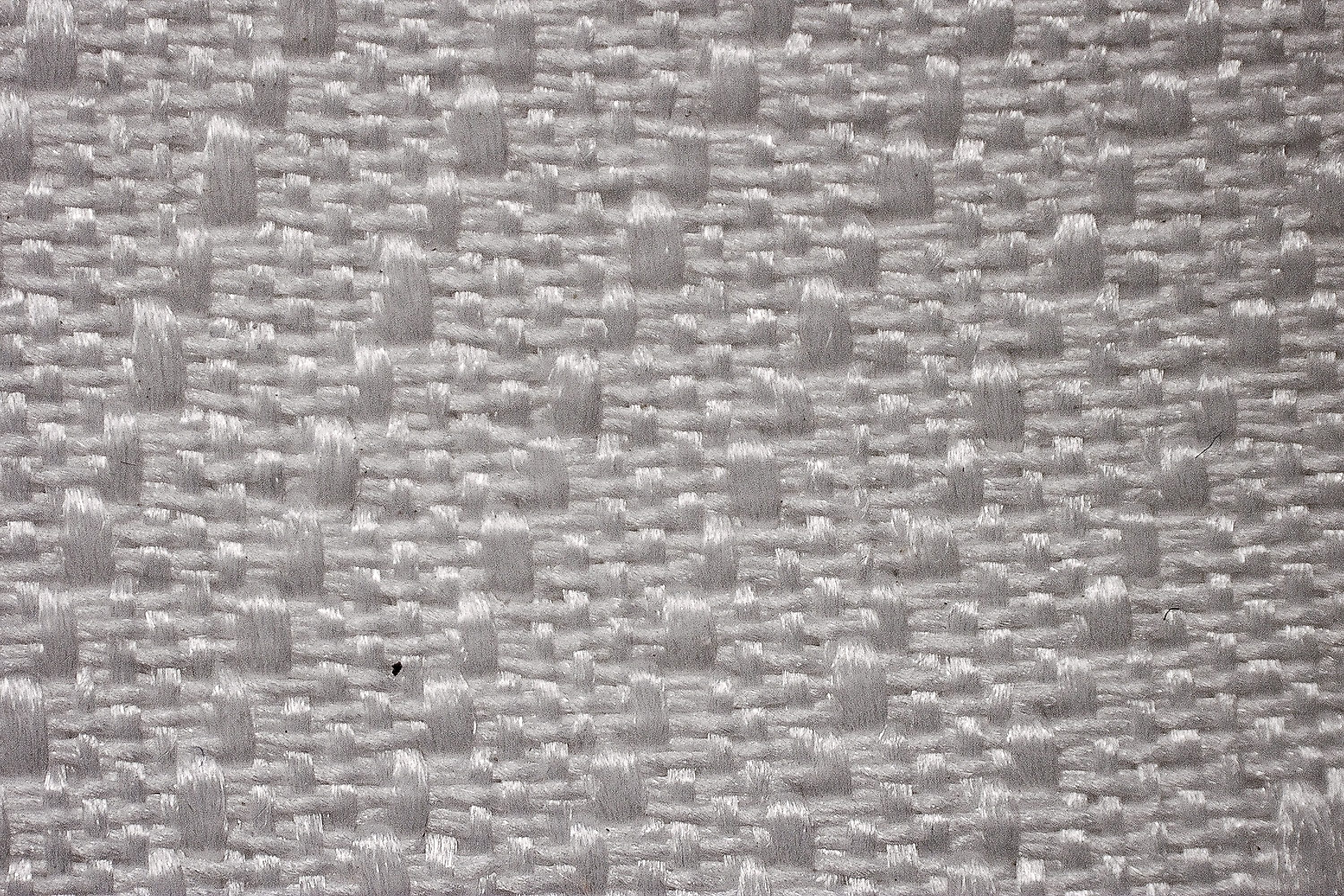
La parte superior da un poco de sí, y tiene un sólido acolchado en el talón. En general, nos parece un buen diseño, pero no es la mejor para los corredores que ponen la transpirabilidad antes que otras características.
| Maxfly 2 | 3 |
| Media | 4.1 |
Estabilidad
Rigidez torsional
Y no solo es que sean rígidas longitudinalmente, sino que a nivel torsional también. Después de casi partirnos los dedos retorciéndolas, decidimos darles un perfecto 5/5 en nuestra escala, que es la puntuación más alta posible.
En nuestras pruebas, comprobamos que esta rigidez tan alta garantiza que las Maxfly 2 mantengan una estabilidad increíble.
| Maxfly 2 | 5 |
| Media | 3.3 |
Rigidez del contrafuerte del talón
El contrafuerte del talón no ha cambiado mucho desde la v1, manteniendo una sólida puntuación en rigidez de 3/5. Aunque no es muy común que las zapatillas de clavos de competición tengan tanta estructura en esta zona, evitar incluso el más mínimo deslizamiento del talón en este tipo de modelos es esencial, y este diseño más rígido asegura el talón.
| Maxfly 2 | 3 |
| Media | 1.7 |
Anchura de la mediasuela - antepié
Ahora vamos a analizar las dimensiones de la mediasuela de las Maxfly 2. Nike ha mantenido la anchura del antepié en 93,5 mm, que, en nuestra opinión, es una decisión acertada.
Si fuese más estrecha no ofrecería estabilidad, y más ancha habría hecho a las Maxfly 2 innecesariamente pesadas.
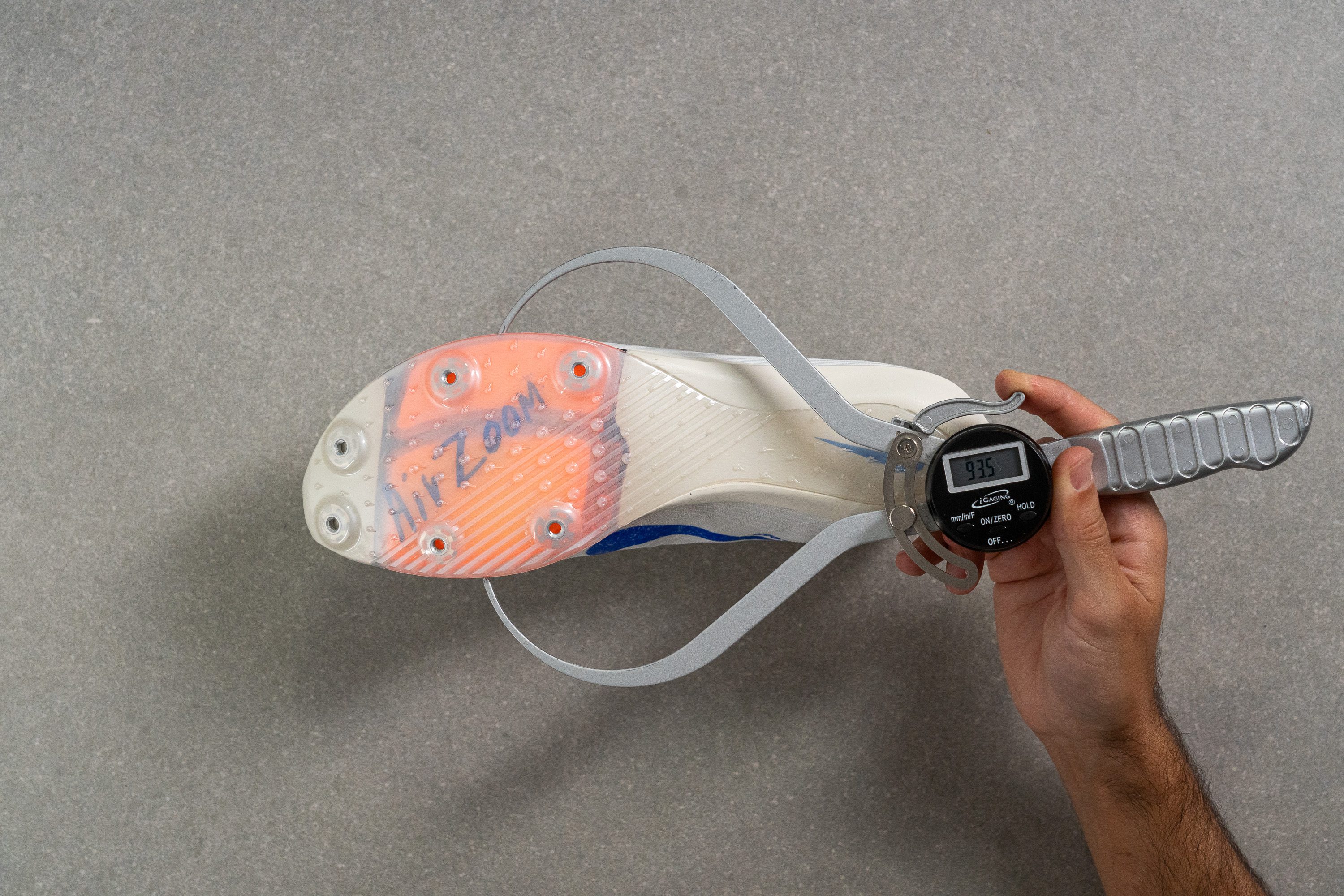
| Maxfly 2 | 93.5 mm |
| Media | 95.1 mm |
Anchura de la mediasuela - talón
El talón se ha modificado para ser más ancho, lo que, sin duda, es un cambio positivo para muchos guerreros del tartán. Algunos velocistas se quejaron de que las Maxfly originales eran algo inestables para los que no son totalmente corredores de antepié (es decir, que no impactan completamente con el antepié).
La diferencia es clara, ya que pasa de 59,2 mm a 66,7 mm. Claramente, esto añade un poco de peso, pero para muchos velocistas es un sacrificio que merece la pena.
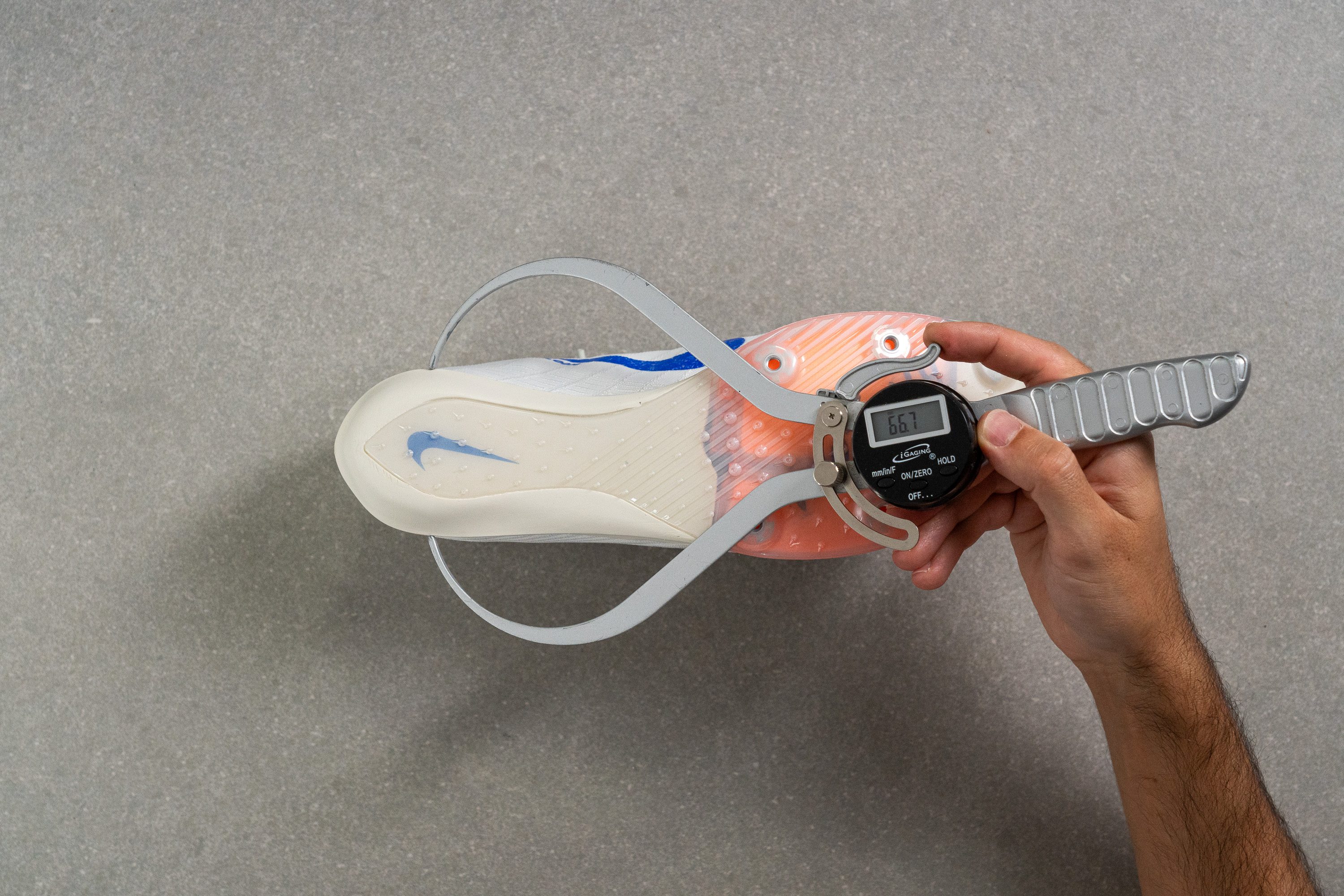
| Maxfly 2 | 66.7 mm |
| Media | 63.0 mm |
Durabilidad
Durabilidad de la parte delantera
La falta de orificios de ventilación no se tradujo en una durabilidad de primera, pero es que para nada.
De hecho, diríamos que hasta terminamos decepcionados. Después de darle caña con nuestro Dremel, terminó tan destrozada que no pudimos darles más que un 1/5 en durabilidad. En nuestra opinión, a Nike le toca ponerse las pilas y dar un paso adelante en este aspecto: si no nos ofrece durabilidad en unas zapatillas, ¡entonces que por lo menos sean medianamente transpirables!
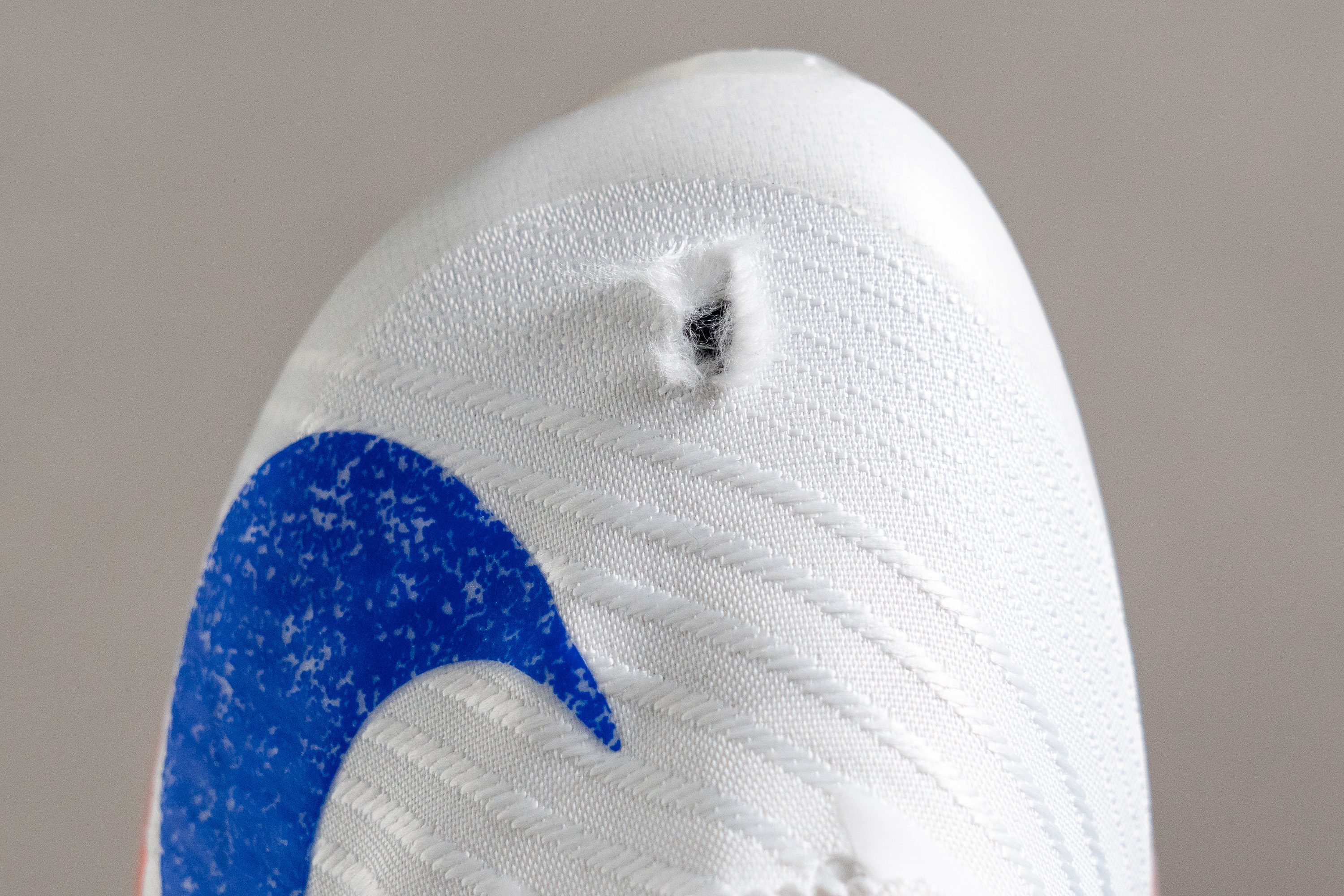
| Maxfly 2 | 1 |
| Media | 2.4 |
Durabilidad del acolchado del talón
El acolchado del talón sí que mejorado un poco en durabilidad, pero no mucho. Una vez más, la verdad es que nos esperábamos algo mejor.
Después de realizar nuestra segunda prueba Dremel, no pudimos darles más que un triste 2/5 en durabilidad del acolchado del talón a estas zapatillas. Este resultado está lejos de ser bueno, y hay todavía mucho que mejorar en nuestra opinión.
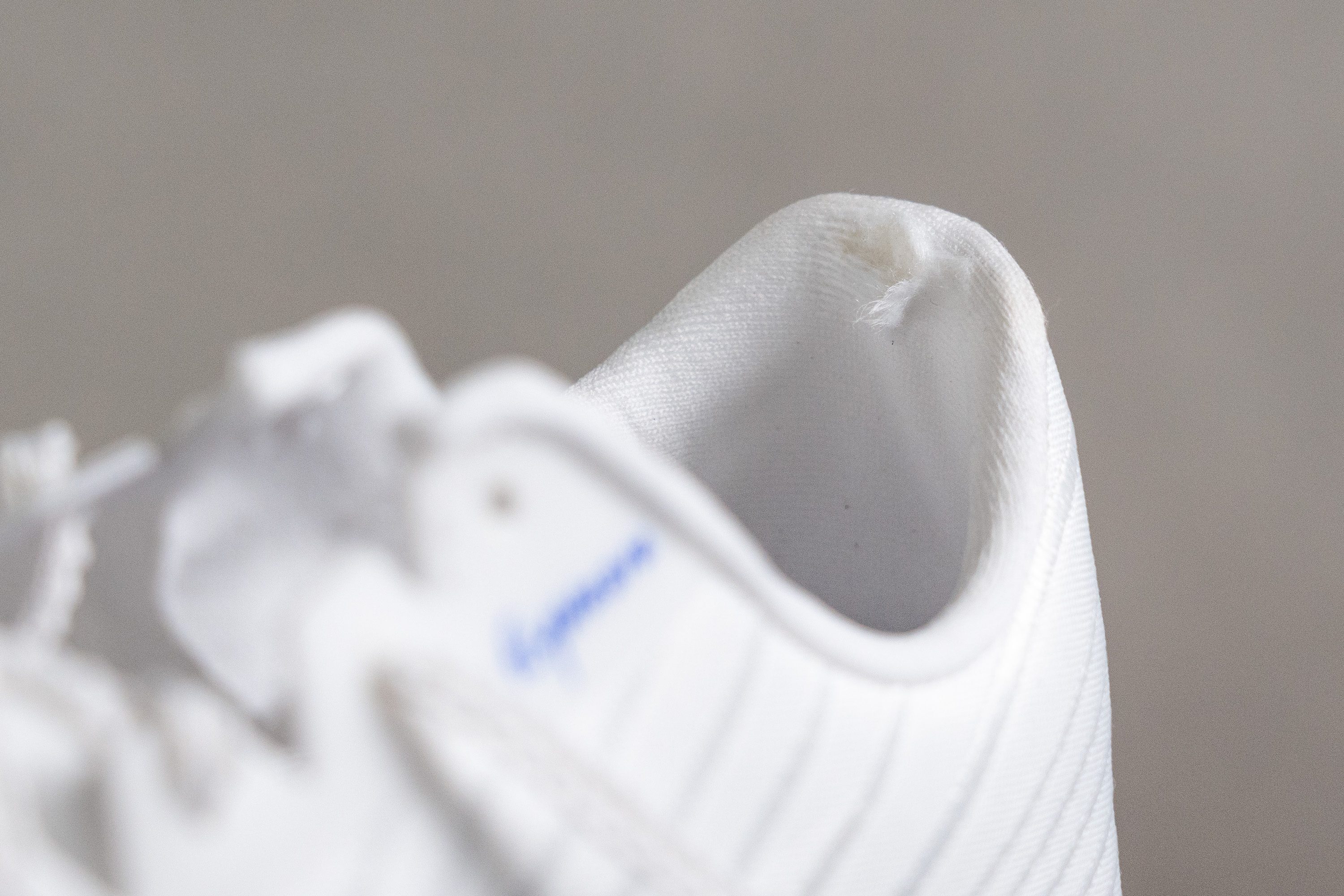
| Maxfly 2 | 2 |
| Media | 3.6 |
Grosor de la suela
Cuando medimos la suela exterior, nos dio 1,9 mm, un grosor que debería ser suficiente.

También nos dimos cuenta de que Nike añadió un montón de tacos de tracción pequeñísimos para echarles una mano a los clavos. En nuestras pruebas de uso comprobamos que funcionan de maravilla, ya que las Maxfly 2 se agarran mucho mejor que la primera versión, que tenía un diseño distinto.
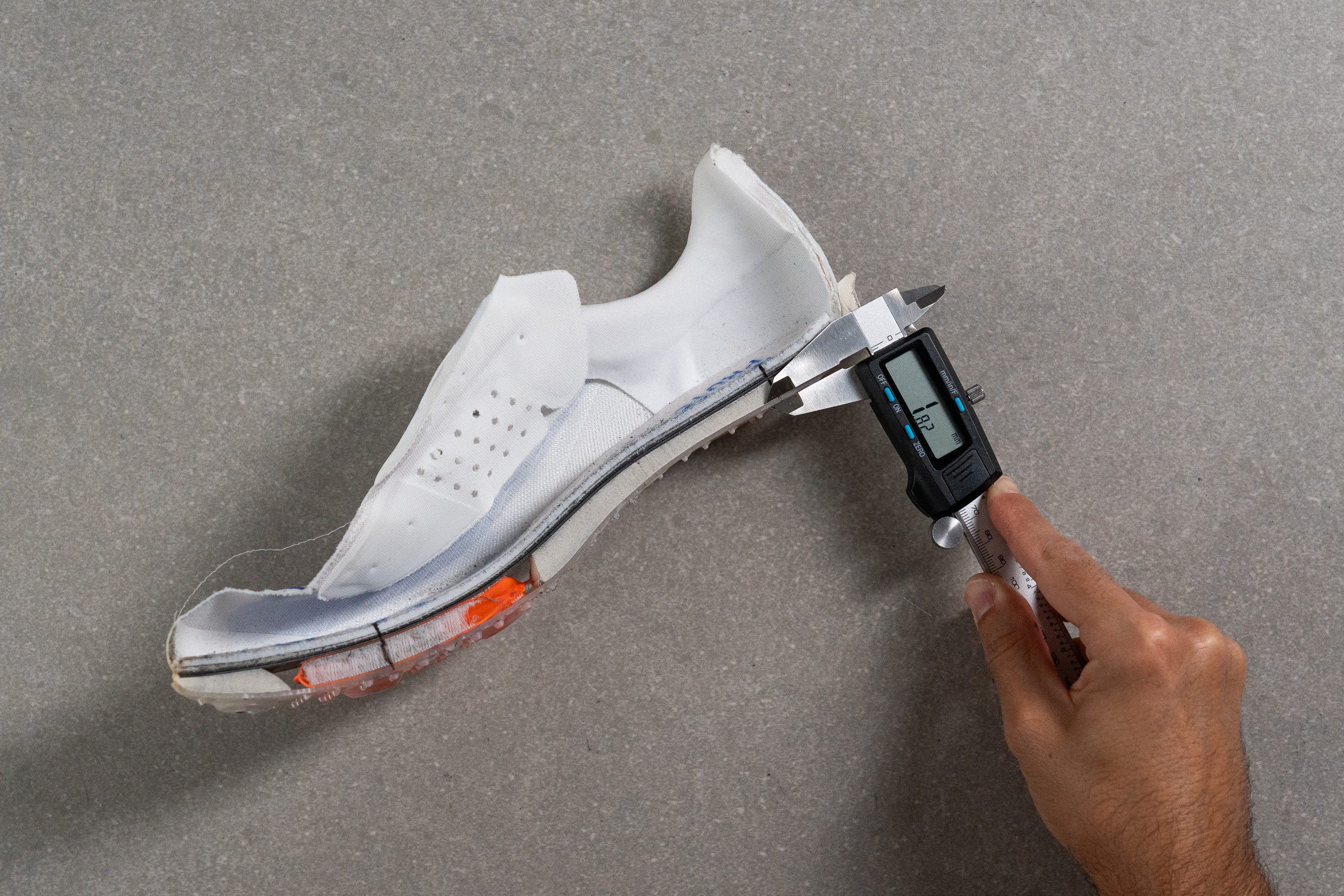
| Maxfly 2 | 1.8 mm |
| Media | 2.7 mm |
Clavos
Nike ha reducido el número de clavos de los 7 que tenían las Maxfly originales a 6. En nuestra experiencia, este cambio ha sido positivo, aunque gracias a la nueva suela exterior pasó totalmente desapercibido en cuanto a tracción.
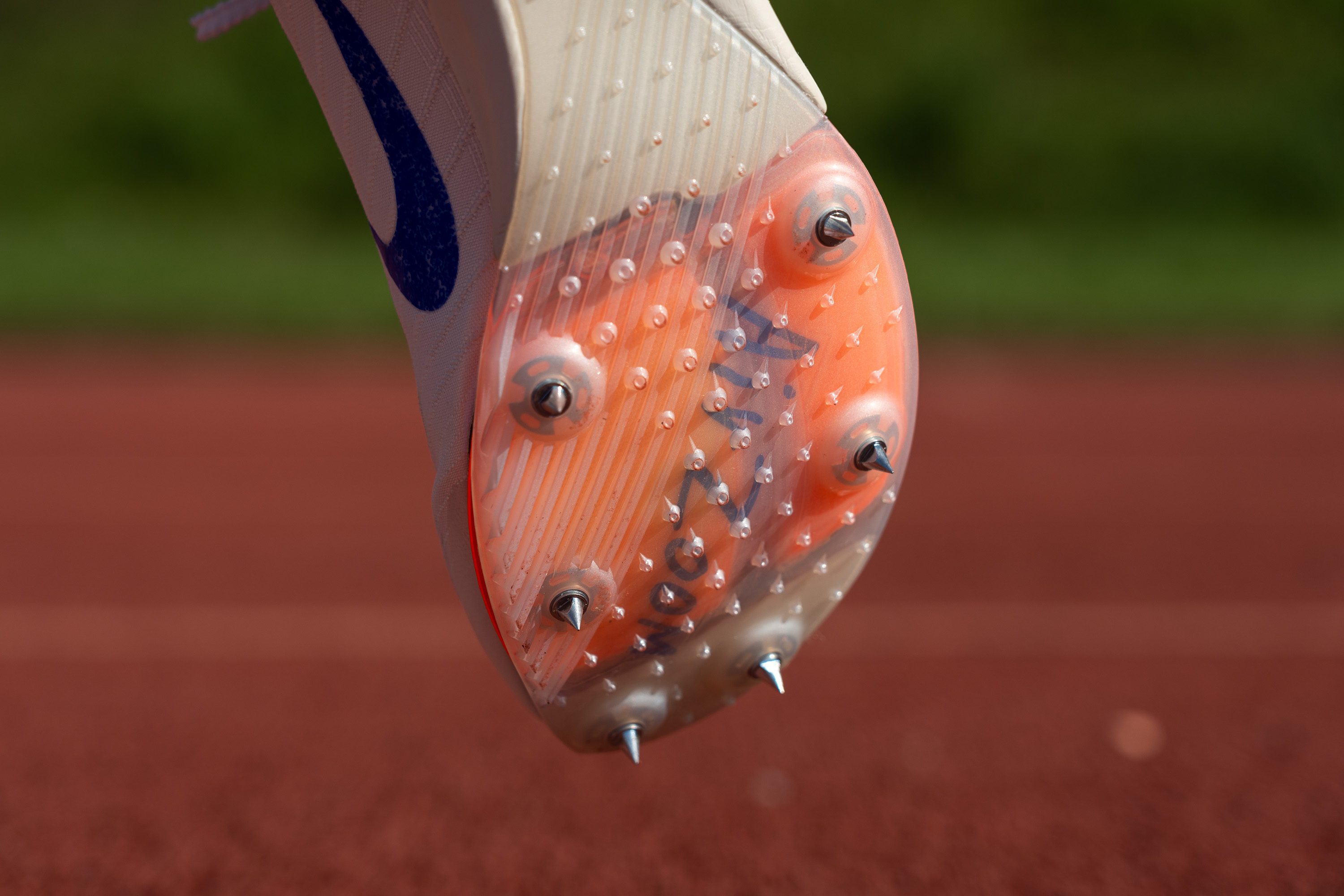
Varios
Grosor de la plantilla
La plantilla es más aerodinámica de lo que solemos encontrar en las zapatillas de competición, pero es justo lo que esperamos en modelo de atletismo de clavos. Sus 3,3 mm la hacen más fina y, a su vez, también más firme para aumentar la reactividad.
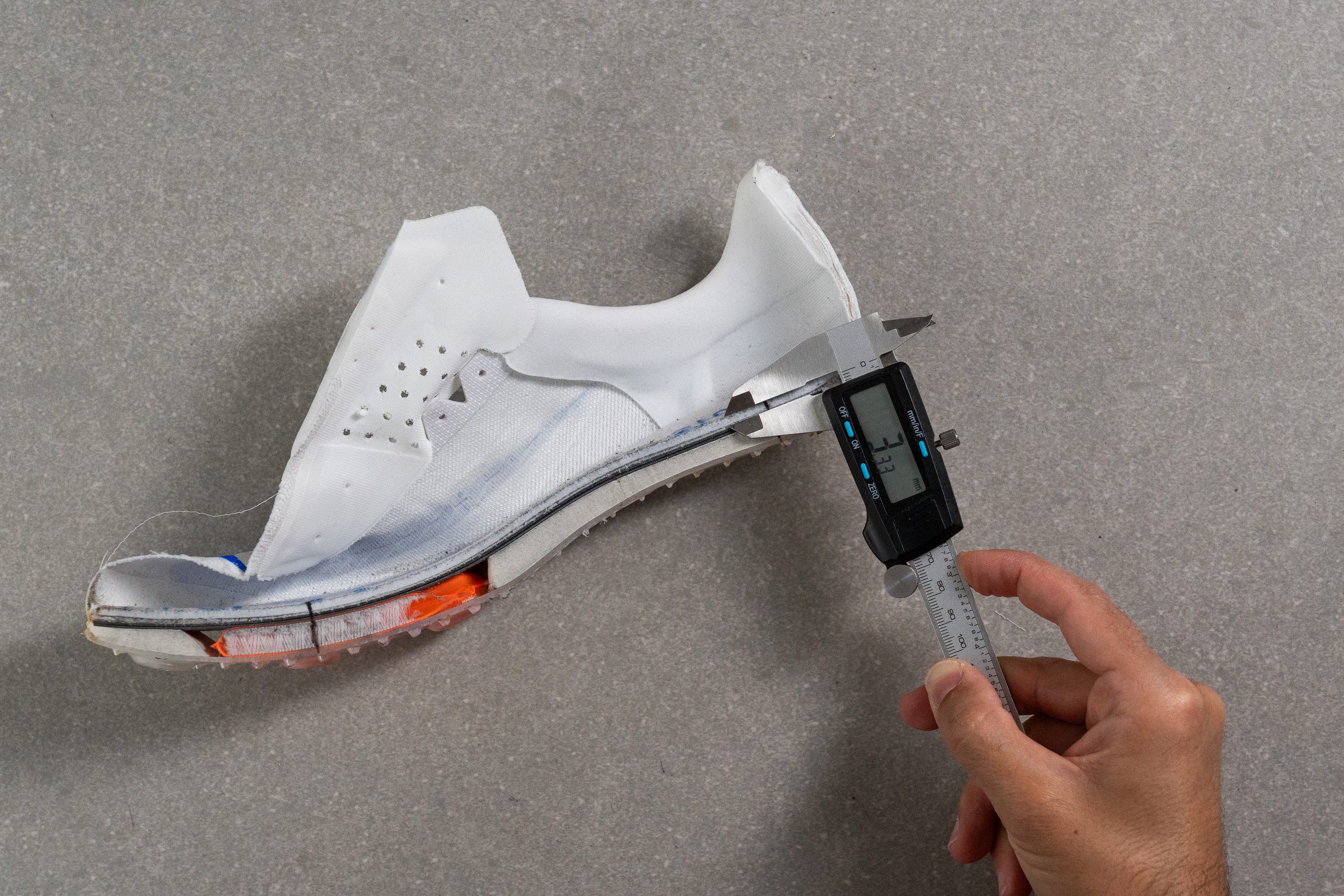
| Maxfly 2 | 3.3 mm |
| Media | 2.9 mm |
Acolchado de la lengüeta
Cuando analizamos las Maxfly originales en el laboratorio, le recomendamos a la marca que redujese el acolchado de su lengüeta, ya que los 3,9 mm que tenían nos parecieron demasiado para zapatillas de alto rendimiento. ¿A vosotros os ha hecho casi Nike? Porque a nosotros tampoco.

Es más, nos ha llevado la contraria, ya que ha aumentado el acolchado hasta los 5,6 mm, superando no solo a sus zapatillas de competición, sino incluso a muchos modelos de entrenamiento diario, como las ASICS Novablast 4. Aunque esto ofrece una protección de primera para el empeine y deja que te ates los cordones con fuerza, nos sigue pareciendo demasiado.

| Maxfly 2 | 5.6 mm |
| Media | 2.3 mm |
Precio
Las Maxfly 2 nunca se diseñaron para ser unas zapatillas de clavos asequibles, y desde luego no lo son. Tienen todas las características premium de los modelos de Nike, y lo de que cuestan una pasta es innegable. Eso sí, en nuestra opinión, el elevado coste está justificado por la mejora del rendimiento para los que quieren batir sus marcas personas. Pero bueno, al final todo depende de lo que tu cartera pueda aguantar.
| Maxfly 2 | $190 |
Tirador del talón
Descubrimos que Nike optó por no incluir un tirador en el talón de las Maxfly 2, y creemos que es una decisión inteligente, porque no habría tenido ningún sentido. Eso sí, el agujero icónico que hemos visto en otros modelos de clavos premium de esta marca, como las Dragonfly 2, les hubiese ido al dedillo, ahorrándose también un poco de peso en el proceso.

| Maxfly 2 | Ninguno |

